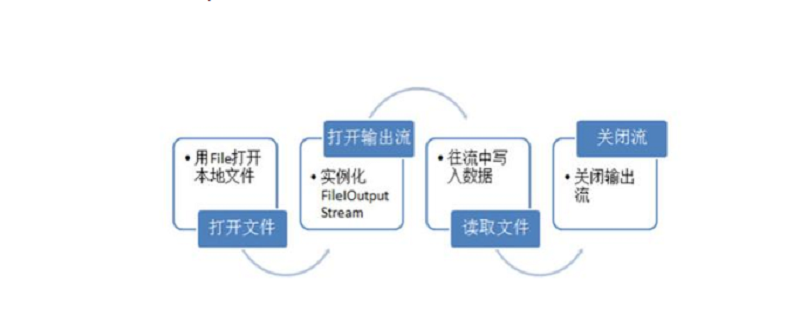Usage of outputstream file output stream in java
Outputstream is a byte output stream in Java. It can be used to output files or strings to a new file. The method of use is: first use the File class to open a file; then use the subroutine of the stream to Class to specify the location; then perform input or output operations; and finally close "Input/Output".

Streams are used to read, write and transmit data. Input and output are for the program itself, but the program needs to read data using read Into the stream, the program needs to save the data output and use the output stream.
Streams are equivalent to various different pipes to transmit data. According to reading and output, it is divided into input stream and output stream. According to the type of transmission, it is divided into byte stream and character stream. According to the relationship between pipelines, it can be divided into node flow and processing flow.
Outputstream is a byte output stream in java, which can be used to output files or strings to a new file. See the original text for specific operations, with code explanations attached.
The output in the byte stream uses the OutputStream class and the input uses the InputStream class.
The operation of streams in java is divided into the following 4 steps:
使用File类打开一个文件 通过流的子类来指定位置 进行输入或输出操作 关闭输入/输出

Byte output stream: OutputStream
The OutputStream class is an abstract class, and its subclass FileOutputStream
import java.io.File;
import java.io.FileInputStream;
import java.io.FileNotFoundException;
import java.io.FileOutputStream;
import java.io.IOException;
import java.io.InputStream;
import java.io.OutputStream;
public class TestOutPutStream {
private static InputStream in;
private static OutputStream out;
public static void main(String[] args) {
try {
in = new FileInputStream("D:/test/testIO.java");
if(in == null){
//原文件不存在
System.out.println("原文件不存在");
}else{
//原文件存在,判断目标文件是否存在
File file = new File("D:/test/testIOO.txt");
if(!file.exists()){
//目标文件不存在,创建目标文件
file.getParentFile().mkdirs();
file.createNewFile();
}
//将原文件内容读取到目标文件
out = new FileOutputStream(file);
int a = 0;
while((a = in.read()) != -1){
out.write(a);
}
}
} catch (FileNotFoundException e) {
// TODO Auto-generated catch block
e.printStackTrace();
} catch (IOException e) {
// TODO Auto-generated catch block
e.printStackTrace();
}finally{
//流关闭
try {
if(in != null){
in.close();
}
if(out != null){
out.close();
}
} catch (IOException e) {
// TODO Auto-generated catch block
e.printStackTrace();
}
}
}
}Through practice, I found that there were files in the original D drive, and new files were generated through outputstream.

The above is the detailed content of Usage of outputstream file output stream in java. For more information, please follow other related articles on the PHP Chinese website!

Hot AI Tools

Undresser.AI Undress
AI-powered app for creating realistic nude photos

AI Clothes Remover
Online AI tool for removing clothes from photos.

Undress AI Tool
Undress images for free

Clothoff.io
AI clothes remover

Video Face Swap
Swap faces in any video effortlessly with our completely free AI face swap tool!

Hot Article

Hot Tools

Notepad++7.3.1
Easy-to-use and free code editor

SublimeText3 Chinese version
Chinese version, very easy to use

Zend Studio 13.0.1
Powerful PHP integrated development environment

Dreamweaver CS6
Visual web development tools

SublimeText3 Mac version
God-level code editing software (SublimeText3)

Hot Topics
 1386
1386
 52
52
 How to correctly divide business logic and non-business logic in hierarchical architecture in back-end development?
Apr 19, 2025 pm 07:15 PM
How to correctly divide business logic and non-business logic in hierarchical architecture in back-end development?
Apr 19, 2025 pm 07:15 PM
Discussing the hierarchical architecture problem in back-end development. In back-end development, common hierarchical architectures include controller, service and dao...
 How to restrict access to specific interfaces of nested H5 pages through OAuth2.0's scope mechanism?
Apr 19, 2025 pm 02:30 PM
How to restrict access to specific interfaces of nested H5 pages through OAuth2.0's scope mechanism?
Apr 19, 2025 pm 02:30 PM
How to use OAuth2.0's access_token to achieve control of interface access permissions? In the application of OAuth2.0, how to ensure that the...
 In back-end development, how to distinguish the responsibilities of the service layer and the dao layer?
Apr 19, 2025 pm 01:51 PM
In back-end development, how to distinguish the responsibilities of the service layer and the dao layer?
Apr 19, 2025 pm 01:51 PM
Discussing the hierarchical architecture in back-end development. In back-end development, hierarchical architecture is a common design pattern, usually including controller, service and dao three layers...
 In Java remote debugging, how to correctly obtain constant values on remote servers?
Apr 19, 2025 pm 01:54 PM
In Java remote debugging, how to correctly obtain constant values on remote servers?
Apr 19, 2025 pm 01:54 PM
Questions and Answers about constant acquisition in Java Remote Debugging When using Java for remote debugging, many developers may encounter some difficult phenomena. It...
 How to convert names to numbers to implement sorting within groups?
Apr 19, 2025 pm 01:57 PM
How to convert names to numbers to implement sorting within groups?
Apr 19, 2025 pm 01:57 PM
How to convert names to numbers to implement sorting within groups? When sorting users in groups, it is often necessary to convert the user's name into numbers so that it can be different...
 How to choose Java project management tools when learning back-end development?
Apr 19, 2025 pm 02:15 PM
How to choose Java project management tools when learning back-end development?
Apr 19, 2025 pm 02:15 PM
Confused with choosing Java project management tools for beginners. For those who are just beginning to learn backend development, choosing the right project management tools is crucial...
 When Tomcat loads Spring-Web modules, does the SPI mechanism really destroy the visibility principle of Java class loaders?
Apr 19, 2025 pm 02:18 PM
When Tomcat loads Spring-Web modules, does the SPI mechanism really destroy the visibility principle of Java class loaders?
Apr 19, 2025 pm 02:18 PM
Analysis of class loading behavior of SPI mechanism when Tomcat loads Spring-Web modules. Tomcat is used to discover and use the Servle provided by Spring-Web when loading Spring-Web modules...
 How to analyze the cracking process of IntelliJ IDEA and find the lib or class responsible for registration?
Apr 19, 2025 pm 04:00 PM
How to analyze the cracking process of IntelliJ IDEA and find the lib or class responsible for registration?
Apr 19, 2025 pm 04:00 PM
Regarding the analysis method of IntelliJIDEA cracking in the programming world, IntelliJ...




